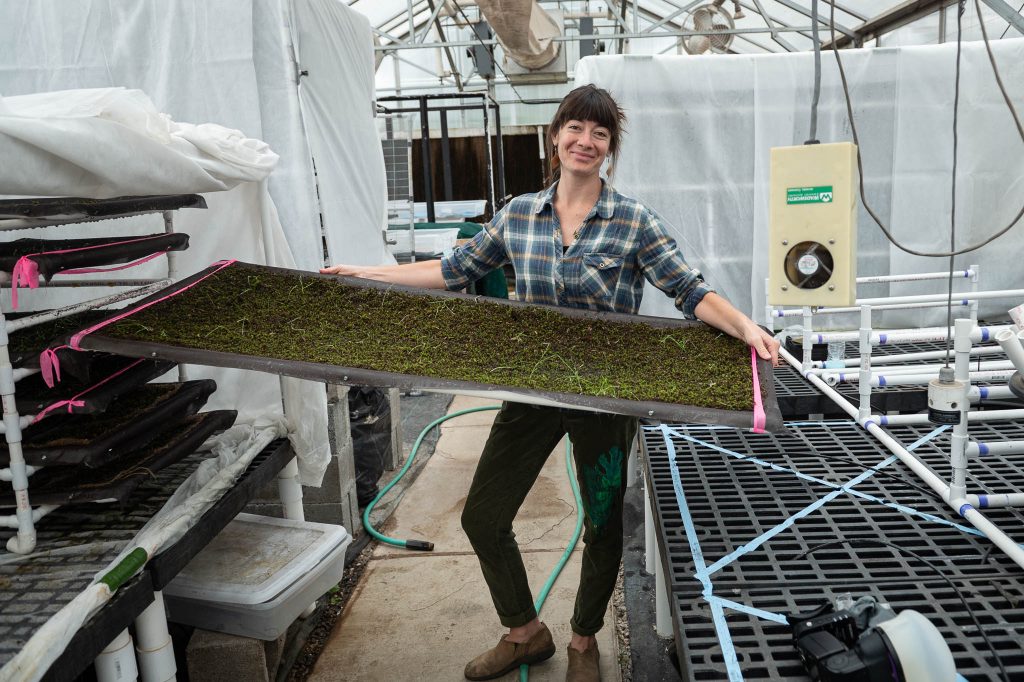Jasmine Anenberg, PhD student

Interviewed by STICH Scholar and Ecoss social media specialist Kayla Blair.
Meet Jasmine Anenberg, a PhD student in the Bowker lab! This lab’s main job is to learn about and restore soil function to areas that have been degraded, by preventing erosion, stimulating nutrient cycling and productivity, or manipulating water infiltration. She works specifically with biological soil crusts, or “biocrusts,” which is a community of many different organisms living on or within the top few millimeters of soil. It’s composed of microscopic things like cyanobacteria and other bacteria, algae, and fungi, and macroscopic things like mosses and lichens, that are all living together like a mini-ecosystem. Biocrusts even provide habitat for tiny and amazing soil critters like nematodes or water bears. Her primary field site is MPG Ranch near Florence, Montana in the Bitterroot Valley, and she focuses on learning about the ecology of these biocrusts and how to actively restore them.
What does a day in your life look like?
I picked this program because of the large variety of projects and outdoor work; I didn’t want a 5-year program that was strictly computer-based. Some days I’ll be in the field hiking steep slopes to recover buried nutrient probes or stooped over my restoration experiments to record moss cover, some days I’ll be in the greenhouse where we grow biocrust in a foggy growth chamber, and other times I’m in the lab identifying moss and lichen species under the microscope or measuring their functional traits.
We take a lot of non-fancy equipment to the field, and sometimes it feels a little silly to me to poke at dirt or pick up dirt and drop it in water to determine soil stability when other soil scientists are coming back with gas flux data or LiDAR data, but I love what I do! Nowadays, I go up to Montana 2-3 times a year for around a week at a time, although I was lucky enough to spend several months working up there during the summer before officially moving to Flagstaff. We have put in a lot of effort over the past two years to install new restoration experiments. My final installation is this year and the rest of the time will be spent monitoring these experiments.
What have been some challenges you’ve seen in communicating your science with the public?
Trying to deal with the mass amount of news headlines and misinformation specifically designed to get your attention that never tell the full story. It feels like I’m trying to correct distorted views and ideas when I talk to the public, and it’s sometimes tricky to find the right words.
What is your favorite part of your research?
THE PEOPLE! I love biocrusts and the solution-focused work that I do; but I also feel really lucky to work in a supportive, collaborative, and humor-filled environment. Our lab meetings are large because we invite anyone who is vaguely interested in soil, and we are even multigenerational: Dr. Nancy Johnson aka the queen of arbuscular mycorrhizae also meets with us, who advised my advisors during grad school.
What is something unexpected you’ve encountered in your research?
How much we DON’T know about the world! There’s a lot of freedom in coming up with an idea or question and being able to just move in that direction and find answers to things that no one knows.
Besides your work at Ecoss, what is something else you enjoy doing or learning about?
Flagstaff is a magical place and I love exploring! I like to rock climb, canyoneer, ski, organize costume-mandatory bike parties with my friends, and above all, hang out with my dog. I also love art as much as science; I attend a lot of live music, film, and anything weird or experimental at the amazing art and performance spaces around Flagstaff. I am also a radio DJ at Kjack (107.1 FM) and Radio Sunnyside (101.5 FM).
How do you hope your research will impact your community and society?
I hope to bring a little more awareness to the below-ground world, since it is often out of sight/out of mind. Soil is so tied to our health, our sustenance, and the survival of future generations, so I hope to improve our tools for managing healthy soil in a fast-changing climate and society.